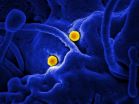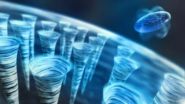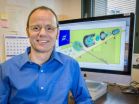(Press-News.org) WHAT:
National Institutes of Health (NIH) scientists have found that Middle East respiratory syndrome coronavirus (MERS-CoV) infection in marmosets closely mimics the severe pneumonia experienced by people infected with MERS-CoV, giving scientists the best animal model yet for testing potential treatments. Researchers at NIH's National Institute of Allergy and Infectious Diseases (NIAID) used marmosets after predicting in computer models that the animals could be infected with MERS-CoV based on the binding properties of the virus.
The same NIAID group in December 2012 developed the first animal model of MERS-CoV infection using rhesus macaques. That model has proven difficult to use for evaluating potential treatments because it mimics mild to moderate human disease, and the animals quickly recover from infection. Several research groups are working to develop mouse models of MERS-CoV infection, but they have yet to establish a severe disease model.
The MERS outbreak, which began in 2012, continues throughout the Middle East. Since the outbreak began, NIAID researchers have focused on understanding how the virus causes disease and how it can be treated effectively. As of July 23rd, the World Health Organization has reported a total of 837 human cases of MERS-CoV infection, including at least 291 deaths.
INFORMATION:
ARTICLES:
D Falzarano et al. Infection with MERS-CoV Causes Lethal Pneumonia in the Common Marmoset. PLoS Pathogens DOI: 10.1371/journal.ppat.1004250 (2014).
N van Doremalen et al. Host species restriction of Middle East respiratory syndrome coronavirus through its receptor dipeptidyl peptidase 4. Journal of Virology DOI: 10.1128/JVI.00676-14 (2014).
WHO:
Vincent Munster, Ph.D., chief of the Virus Ecology Unit in NIAID's Laboratory of Virology, is available for interviews.
CONTACT:
To schedule interviews, please contact Ken Pekoc, (301) 402-1663, kpekoc@niaid.nih.gov.
NIAID conducts and supports research—at NIH, throughout the United States, and worldwide—to study the causes of infectious and immune-mediated diseases, and to develop better means of preventing, diagnosing and treating these illnesses. News releases, fact sheets and other NIAID-related materials are available on the NIAID Web site at http://www.niaid.nih.gov.
About the National Institutes of Health (NIH): NIH, the nation's medical research agency, includes 27 Institutes and Centers and is a component of the U.S. Department of Health and Human Services. NIH is the primary federal agency conducting and supporting basic, clinical, and translational medical research, and is investigating the causes, treatments, and cures for both common and rare diseases. For more information about NIH and its programs, visit http://www.nih.gov.
NIH...Turning Discovery Into Health®
NIH scientists establish new monkey model of severe MERS-CoV disease
Marmosets may provide best option yet for testing potential treatments, study suggests
2014-08-21
ELSE PRESS RELEASES FROM THIS DATE:
How hummingbirds evolved to detect sweetness
2014-08-21
Everything about hummingbirds is rapid. An iridescent blur to the human eye, their movements can be captured with clarity only by high-speed video.
Slowed down on replay, their wings thrum like helicopter blades as they hover near food. Their hearts beat 20 times a second and their tongues dart 17 times a second to slurp from a feeding station.
It takes only three licks of their forked, tube-like tongues to reject water when they expect nectar. They pull their beaks back, shake their heads and spit out the tasteless liquid. They also are not fooled by the sugar substitute ...
From dandruff to deep sea vents, an ecologically hyper-diverse fungus
2014-08-21
A ubiquitous skin fungus linked to dandruff, eczema and other itchy, flaky maladies in humans has now been tracked to even further global reaches—including Hawaiian coral reefs and the extreme environments of arctic soils and deep sea vents.
A review in the scientific journal PLOS Pathogens considers the diversity, ecology, and distribution of the fungi of the genus Malassezia in light of new insights gained from screening environmental sequencing datasets from around the world.
University of Hawai'i at Mānoa scientist Anthony Amend discovered that members of this ...
New properties of rotating superfluids discovered in helium nanodroplets
2014-08-21
Liquid helium, when cooled down nearly to absolute zero, exhibits unusual properties that scientists have struggled to understand: it creeps up walls and flows freely through impossibly small channels, completely lacking viscosity. It becomes a new state of matter – a "superfluid."
Now, a large, international team of researchers led by scientists at USC, Stanford and Berkeley has used X-rays from a free-electron laser to peer inside individual droplets of liquid helium, exploring whether this liquid helium retains its superfluid characteristics even at microscopic scales ...
Severe drought is causing the western US to rise
2014-08-21
The severe drought gripping the western United States in recent years is changing the landscape well beyond localized effects of water restrictions and browning lawns. Scientists at Scripps Institution of Oceanography at UC San Diego have now discovered that the growing, broad-scale loss of water is causing the entire western U.S. to rise up like an uncoiled spring.
Investigating ground positioning data from GPS stations throughout the west, Scripps researchers Adrian Borsa, Duncan Agnew, and Dan Cayan found that the water shortage is causing an "uplift" effect up to ...
X-ray laser probes tiny quantum tornadoes in superfluid droplets
2014-08-21
An experiment at the Department of Energy's SLAC National Accelerator Laboratory revealed a well-organized 3-D grid of quantum "tornadoes" inside microscopic droplets of supercooled liquid helium – the first time this formation has been seen at such a tiny scale.
The findings by an international research team provide new insight on the strange nanoscale traits of a so-called "superfluid" state of liquid helium. When chilled to extremes, liquid helium behaves according to the rules of quantum mechanics that apply to matter at the smallest scales and defy the laws of classical ...
Researchers map quantum vortices inside superfluid helium nanodroplets
2014-08-21
Scientists have, for the first time, characterized so-called quantum vortices that swirl within tiny droplets of liquid helium. The research, led by scientists at the U.S. Department of Energy's Lawrence Berkeley National Laboratory (Berkeley Lab), the University of Southern California, and SLAC National Accelerator Laboratory, confirms that helium nanodroplets are in fact the smallest possible superfluidic objects and opens new avenues to study quantum rotation.
"The observation of quantum vortices is one of the most clear and unique demonstrations of the quantum properties ...
Sunlight, not microbes, key to CO2 in Arctic
2014-08-21
CORVALLIS, Ore. – The vast reservoir of carbon stored in Arctic permafrost is gradually being converted to carbon dioxide (CO2) after entering the freshwater system in a process thought to be controlled largely by microbial activity.
However, a new study – funded by the National Science Foundation and published this week in the journal Science – concludes that sunlight and not bacteria is the key to triggering the production of CO2 from material released by Arctic soils.
The finding is particularly important, scientists say, because climate change could affect when ...
A novel 'man and machine' decision support system makes malaria diagnostics more effective
2014-08-21
A Finnish-Swedish research group at the Institute for Molecular Medicine Finland (FIMM), University of Helsinki, and Karolinska institutet, Stockholm, has developed a novel "man and machine" decision support system for diagnosing malaria infection. This innovative diagnostic aid was described in PLOS One scientific journal today, 21 August. The method is based on computer vision algorithms similar to those used in facial recognition systems combined with visualization of only the diagnostically most relevant areas. Tablet computers can be utilized in viewing the images.
In ...
Scientists observe quantum vortices in cold helium droplets
2014-08-21
An international research team including DESY scientists has observed tiny quantum vortices in cold droplets of liquid helium. The team reports in the journal Science that the exotic vortices arrange themselves as densely packed lattices inside the nanodroplets. It is the first time that the quantum vortices, which have already been observed in larger samples of what is known as superfluid helium, have been detected in nanodroplets. "The experiment has exceeded our best expectations," says Andrey Vilesov of the University of Southern California, one of the experiment's ...
Hot-spring bacteria reveal ability to use far-red light for photosynthesis
2014-08-21
Bacteria growing in near darkness use a previously unknown process for harvesting energy and producing oxygen from sunlight, a research team led by a Penn State University scientist has discovered. The discovery lays the foundation for further research aimed at improving plant growth, harvesting energy from the Sun, and understanding dense blooms like those now occurring on Lake Erie and other lakes worldwide. A paper describing the discovery will be published in the Science Express edition of the journal Science on 21 August 2014.
"We have shown that some cyanobacteria, ...
LAST 30 PRESS RELEASES:
University of Oklahoma researcher awarded funding to pursue AI-powered material design
Exploring how the visual system recovers following injury
Support for parents with infants at pediatric check-ups leads to better reading and math skills in elementary school
Kids’ behavioral health is a growing share of family health costs
Day & night: Cancer disrupts the brain’s natural rhythm
COVID-19 vaccination significantly reduces risk to pregnant women and baby
The role of vaccination in maternal and perinatal outcomes associated with COVID-19 in pregnancy
Mayo Clinic smartwatch system helps parents shorten and defuse children's severe tantrums early
Behavioral health spending spikes to 40% of all children’s health expenditures, nearly doubling in a decade
Digital cognitive behavioral treatment for generalized anxiety disorder
Expenditures for pediatric behavioral health care over time and estimated family financial burden
Air conditioning in nursing homes and mortality during extreme heat
The Alps to lose a record number of glaciers in the next decade
What makes a good proton conductor?
New science reporting guide published for journalists in Bulgaria
New international study reveals major survival gaps among children with cancer
New science reporting guide published for journalists in Turkey
Scientists develop a smarter mRNA therapy that knows which cells to target
Neuroanatomy-informed brain–machine hybrid intelligence for robust acoustic target detection
Eight SwRI hydrogen projects funded by ENERGYWERX
The Lundquist Institute and its start-up company Vitalex Biosciences Announces Strategic Advancement of Second-Generation fungal Vaccine VXV-01 through Phase 1 Trials under $40 Million Competitive Con
Fine particles in pollution are associated with early signs of autoimmune disease
Review article | Towards a Global Ground-Based Earth Observatory (GGBEO): Leveraging existing systems and networks
Penn and UMich create world’s smallest programmable, autonomous robots
Cleveland researchers launch first major study to address ‘hidden performance killer’ in athletes
To connect across politics, try saying what you oppose
Modulating key interaction prevents virus from entering cells
Project explores barriers to NHS career progression facing international medical graduates
Jeonbuk National University researchers explore the impact of different seasonings on the flavor perception of Doenjang soup
Two Keck Medicine of USC Hospitals named Leapfrog Top Teaching Hospitals
[Press-News.org] NIH scientists establish new monkey model of severe MERS-CoV diseaseMarmosets may provide best option yet for testing potential treatments, study suggests






